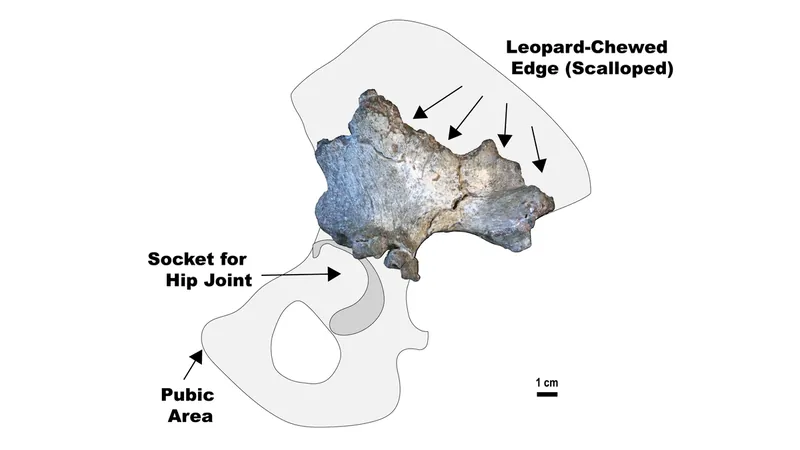
Did a Leopard Feast on Our Smallest Ancestor? Uncovering the Mystery of the Paranthropus robustus
2025-03-20
Author: Nur
Did a Leopard Feast on Our Smallest Ancestor?
In a groundbreaking discovery, scientists in South Africa have unearthed one of the smallest known human relatives, the Paranthropus robustus, who stood at just 3 feet, 4.5 inches (1.03 meters) tall. This remarkable find, dating back 2 million years, poses intriguing questions about the evolutionary journey of early hominins. Notably, this tiny specimen, referred to as SWT1/HR-2, is even shorter than the famous 'Lucy' from Ethiopia, emphasizing the diverse range of our ancestors.
Unique Build of Paranthropus robustus
Travis Pickering, a paleoanthropologist from the University of Wisconsin–Madison and lead author of the study published in the Journal of Human Evolution, describes the unique build of this individual. Unlike modern human populations with shorter statures, often referred to as 'pygmies,' the P. robustus was likely stocky, suggesting different physical adaptations to its environment. Researchers hypothesize that this stature might provide insights into survival strategies during periods of environmental shifts.
Significance of the Discovery
The discovery was made in the Swartkrans limestone cave, part of South Africa’s Cradle of Humankind, a UNESCO World Heritage site celebrated for its rich fossil record. The excavation uncovered three connected bones – the left hip, femur, and tibia – belonging to a young adult of the species. The rarity of leg fossils for P. robustus amplifies the significance of this find, enabling a clearer picture of how these early hominins walked and lived.
Dual Lifestyle Adaptability
Notably, elements of the leg bones suggest a dual lifestyle; the robust hip bones indicate an ability for bipedal locomotion, yet the structure of the leg bones hints at a capability for climbing. This adaptability could have allowed P. robustus to forage for food in trees or escape predators, highlighting their survival tactics in a tumultuous environment.
Cause of Death: Leopard Attack?
However, one of the study’s most startling revelations revolves around the enigmatic cause of death for this P. robustus. Upon close examination, researchers determined that this young female likely met her end by a leopard, a formidable predator known to inhabit the region. Analysis of the bones revealed specific tooth marks consistent with leopard bites, and considering the small size of this hominin, weighing approximately 60.4 pounds (27.4 kg), it fit comfortably within the prey profile of leopards which often weigh around 55 pounds (25 kilograms).
Unresolved Questions about Size
Despite the insights gained, the true reason behind the small size of P. robustus remains uncertain. Study co-author Jason Heaton from the University of Alabama at Birmingham states that it's unlikely that insular dwarfism—a phenomenon where species evolve smaller sizes due to resource competition—were a factor here. Instead, variations might stem from natural differences within the species, dietary factors, or developmental constraints.
Future Research and Excavations
The research team is optimistic about further excavations, confident that more bones could be recovered from SWT1/HR-2, providing even more insights into the life and times of this small, yet fascinating human relative. Understanding the life history of P. robustus could illuminate parts of our evolutionary narrative that remain shrouded in mystery. Will we uncover more secrets about our smallest ancestor? Stay tuned, as the journey into our distant past continues!


 Brasil (PT)
Brasil (PT)
 Canada (EN)
Canada (EN)
 Chile (ES)
Chile (ES)
 Česko (CS)
Česko (CS)
 대한민국 (KO)
대한민국 (KO)
 España (ES)
España (ES)
 France (FR)
France (FR)
 Hong Kong (EN)
Hong Kong (EN)
 Italia (IT)
Italia (IT)
 日本 (JA)
日本 (JA)
 Magyarország (HU)
Magyarország (HU)
 Norge (NO)
Norge (NO)
 Polska (PL)
Polska (PL)
 Schweiz (DE)
Schweiz (DE)
 Singapore (EN)
Singapore (EN)
 Sverige (SV)
Sverige (SV)
 Suomi (FI)
Suomi (FI)
 Türkiye (TR)
Türkiye (TR)
 الإمارات العربية المتحدة (AR)
الإمارات العربية المتحدة (AR)